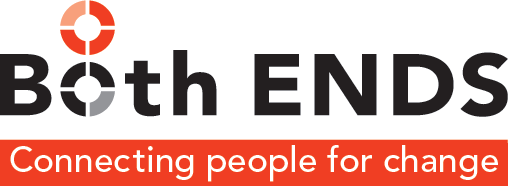DIVERSIFICATION OF FUNDING
RISK: Financial dependence on the Ministry of Foreign Affairs
MITIGATION MEASURE: Further diversification of funding
Both ENDS has continued its partnerships with the Ministry of Foreign Affairs through the FGG Alliance and GAGGA in which FCAM takes the lead. Funding from the Ministry of Foreign Affairs remains our principal source of income, which is why further diversifying our sources of income will remain a priority in the coming years. Our fundraising capacity increased significantly in 2016. We employed a fundraiser who coordinates all fundraising activities. We presented several proposals to the European Union and continued our engagement with several foundations in the United States and Europe, thus further broadening our funding network. In addition, we are building strategic relations with a range of actors, both from civil society and from scientific institutions, to broaden our scope and develop joint fundraising activities.
We developed activities in both our communication strategy and our PMEL strategy that focus specifically on the key factors of success in fundraising. One of the aims of these activities is to monitor and demonstrate Both ENDS’ way of working and its concrete impact.
UPSCALING ALTERNATIVE MODELS
RISK: Proactive and ‘homegrown’ approaches to sustainable forest, land and water management for and by local communities may have difficulty attracting funding because of Both ENDS’ outspokenness as an advocacy organisation.
MITIGATION MEASURE: Balance communications and external outreach to show the impact and potential of these approaches. Focus fundraising efforts on generating financial support for these approaches.
Both ENDS’ has increased its outspokenness in recent years regarding contentious topics, such as trade and investment, and public and development financing. This may deter both public and private funders from financing the organisation, irrespective of the type of project that they are being offered. The difficult balance between Both ENDS’ role as a ‘watchdog’ that challenges current power structures, on the one hand, and our desire to work on sustainable alternatives that are key to the transition to a fair and sustainable economy and society, on the other hand, requires us to make an extra effort in our approaches to outreach and fundraising.
ADAPTING TO THE NEW ORGANISATIONAL STRUCTURE
RISK: Employees might not have sufficient time or capacity to implement the new organisational structure and, as a result, will either feel overburdened or will be unable to respond to the organisation’s expectations and needs.
MITIGATION MEASURES: Support staff through direct coaching. Develop an organisational culture of open feedback as a way of identifying bottlenecks and needs for support. Increase the number of specialised support staff who work on PMEL and fundraising, for example, as well as in critical areas such as financial administration. Increase the support budget in line with the organisation’s new strategic focus areas.
The new organisational structure and culture implemented in 2016 may put new pressure on individual staff members. We introduced several new practices, designed by a staff delegation, in a relatively short period of time. The change itself and its implementation are requiring people to make a considerable effort in terms of time and dedication.
In order to support our staff in this organisational transition and help them assume their new responsibilities, we are providing staff with individual support. In addition, the new structure encourages regular check-ins with peers. We have also ensured that some of the new members of staff focus on support processes, such as PMEL and fundraising. The budgets for these activities, as well as for human resources management, will increase according to what is feasible for the organisation, on the one hand, and what the needs of staff are, on the other.
